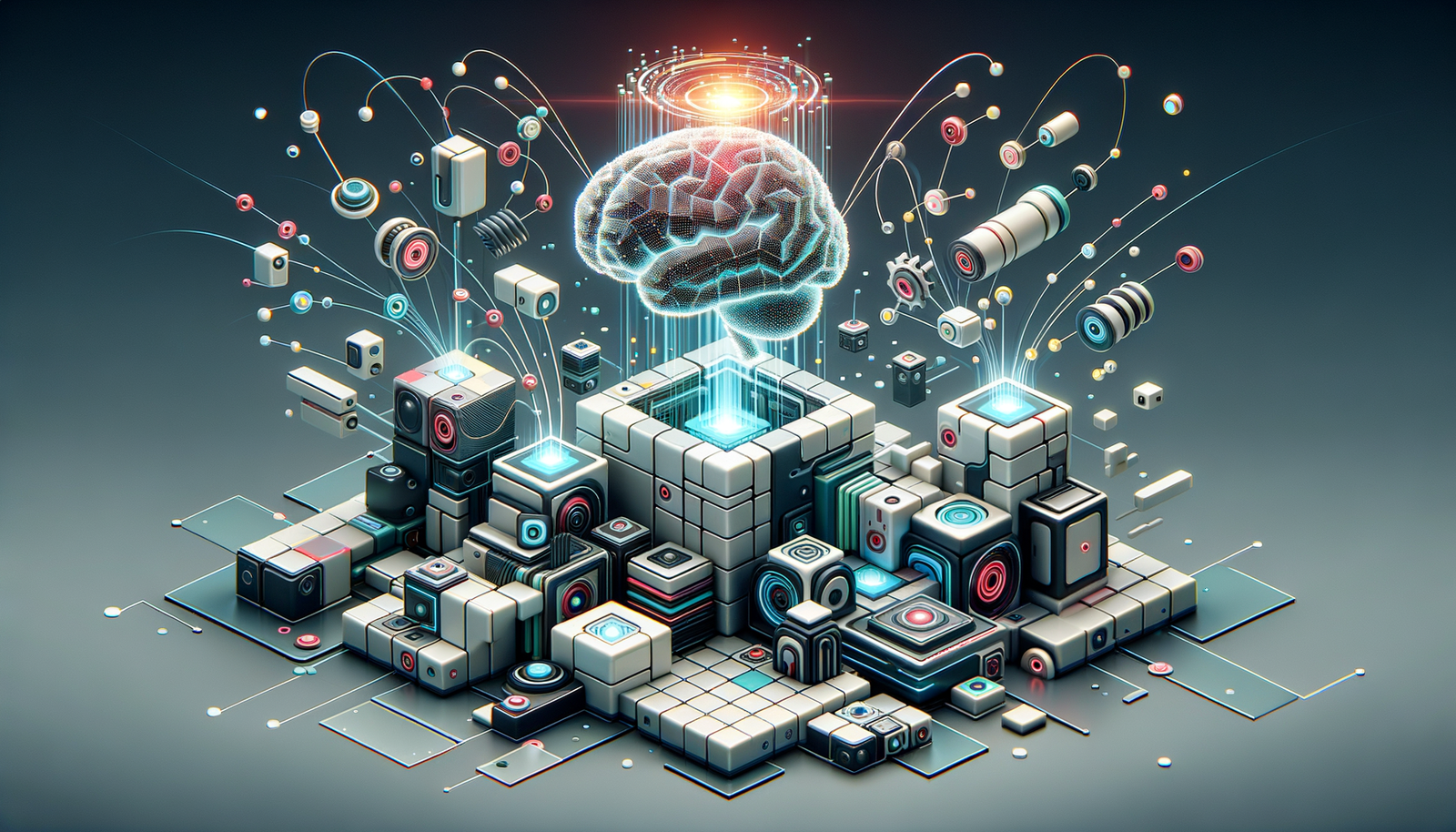Your Cart is Empty
Customer Testimonials
-
"Great customer service. The folks at Novedge were super helpful in navigating a somewhat complicated order including software upgrades and serial numbers in various stages of inactivity. They were friendly and helpful throughout the process.."
Ruben Ruckmark
"Quick & very helpful. We have been using Novedge for years and are very happy with their quick service when we need to make a purchase and excellent support resolving any issues."
Will Woodson
"Scott is the best. He reminds me about subscriptions dates, guides me in the correct direction for updates. He always responds promptly to me. He is literally the reason I continue to work with Novedge and will do so in the future."
Edward Mchugh
"Calvin Lok is “the man”. After my purchase of Sketchup 2021, he called me and provided step-by-step instructions to ease me through difficulties I was having with the setup of my new software."
Mike Borzage
Modular Design Systems: Enhancing Flexibility and Efficiency with AI Integration
April 02, 2025 11 min read


Overview of Modular Design Systems
Modular design systems have become a cornerstone in contemporary engineering and product development, offering a strategic approach to designing complex systems with simplicity and efficiency. At its essence, a modular design system involves the creation of systems that are composed of distinct, interchangeable components or modules. These modules are designed to fit together seamlessly, allowing for easy assembly, disassembly, reconfiguration, and replacement. The key characteristics of modular design include standardization, scalability, flexibility, and reusability. Standardization ensures that modules adhere to specific interfaces and specifications, facilitating compatibility and interoperability. Scalability allows systems to expand or contract by adding or removing modules without the need for significant redesign.
Flexibility in modular design empowers designers and manufacturers to create customized products by rearranging existing modules to meet specific needs. This adaptability is particularly valuable in industries where consumer preferences are diverse and rapidly changing. Reusability of modules contributes to cost savings and efficiency, as the same components can be utilized across different products or systems. Moreover, modularity enhances maintenance and upgrades, as individual modules can be updated or replaced without affecting the entire system. This approach not only streamlines the initial design and production processes but also simplifies future enhancements and repairs.
The importance of modular design systems in modern design and manufacturing is profound. In an era characterized by rapid technological advancements and fierce market competition, companies are under constant pressure to innovate and deliver products efficiently. Modular design addresses these challenges by enabling faster development cycles, reducing time-to-market, and lowering production costs. By utilizing pre-designed modules, companies can accelerate the prototyping and testing phases, allowing for quicker iterations based on market feedback. Furthermore, modularity supports mass customization, where products are tailored to individual customer preferences while maintaining economies of scale associated with mass production. Environmental sustainability is another critical aspect where modular design plays a significant role. By promoting the reuse and recycling of components, modular systems reduce waste and resource consumption, aligning with global efforts toward sustainable manufacturing practices and circular economies. In sectors such as electronics, construction, automotive, and aerospace, modular design has been instrumental in driving innovation, enhancing product quality, and meeting the evolving demands of consumers and regulators alike.
The Rise of Artificial Intelligence in Design
The integration of Artificial Intelligence (AI) into design processes marks a transformative chapter in the evolution of design methodologies. The initial forays into AI integration began with incorporating basic algorithms into computer-aided design (CAD) tools, automating simple tasks and improving accuracy. Over the years, the synergy between AI advancements and design software has intensified, leading to more sophisticated applications. The brief history of AI in design is characterized by gradual progress from rule-based systems to machine learning algorithms capable of self-improvement.
In the early stages, AI applications in design were limited to automating repetitive tasks and enforcing design rules and standards. As computational power increased and data became more abundant, machine learning and deep learning algorithms opened new horizons. AI began to assist in optimizing designs for performance, cost, and manufacturability by analyzing large datasets and learning from previous projects. This evolution has enabled design software to not only automate tasks but also to provide intelligent insights and recommendations.
Current trends and advancements in AI integration involve the use of advanced neural networks, generative adversarial networks (GANs), and reinforcement learning in design. These technologies allow for the exploration of complex design spaces and the generation of innovative solutions that may not be attainable through traditional means. AI is now capable of understanding context, predicting trends, and even emulating human creativity to some extent. Additionally, cloud computing and big data analytics have enhanced the scalability and accessibility of AI-powered design tools. Designers can leverage AI to collaborate in real-time, access vast computational resources, and utilize sophisticated algorithms previously constrained to high-end computing systems. The rise of AI in design signifies a shift toward more intelligent, adaptive, and user-centered design processes, presenting an opportunity to redefine how products are conceived, evaluated, and implemented.
Purpose of Advanced Customization
Advanced customization in design and manufacturing serves as a strategic response to the increasing demand for personalized products and services. The purpose is to enhance flexibility and adaptability within design systems, allowing businesses to cater to the individual preferences and requirements of clients. In a global market where consumers seek products that reflect their unique identities and needs, advanced customization becomes a competitive differentiator.
By adopting advanced customization, companies can meet diverse client needs and market demands effectively. It involves utilizing technologies such as AI and modular design principles to create systems that are both flexible and scalable. This approach enables the rapid development of customized solutions without the significant cost and time implications traditionally associated with bespoke designs. Key benefits include:
- Improved customer satisfaction: Tailoring products to client specifications enhances the user experience and builds brand loyalty.
- Market differentiation: Offering customized solutions sets businesses apart from competitors, appealing to niche markets.
- Resource efficiency: Utilizing modular components in customization reduces waste and optimizes manufacturing processes.
- Increased revenue opportunities: Customization can command premium pricing and open up additional market segments.
Advanced customization also leverages data analytics and AI to predict market trends and consumer behaviors, enabling proactive adjustments to product offerings. This agility allows businesses to stay ahead of market shifts, ensuring that they remain relevant and competitive.
Machine Learning Algorithms
Machine learning algorithms serve as the engine driving AI technologies in advanced customization. These algorithms enable systems to learn from data, identify patterns, and make decisions with minimal human intervention. In the context of design, machine learning facilitates the personalization of design parameters based on user preferences, usage data, and environmental factors.
Personalizing design parameters involves analyzing user data to tailor products that meet specific needs. For instance, wearable technology can be customized based on individual biometric data collected over time, ensuring an optimal fit and function. Machine learning models can process this data to recommend design adjustments automatically.
Predictive analytics for design optimization is another critical application. By leveraging historical data and real-time inputs, machine learning algorithms can predict how design changes will impact product performance, cost, and user satisfaction. This allows designers to make informed decisions and optimize designs for various objectives, such as maximizing efficiency or minimizing material usage.
The use of machine learning in design also supports the development of intelligent systems capable of adapting to new information. This adaptability is essential in rapidly changing markets or technologies, where products must evolve continuously to remain relevant. Machine learning algorithms enable systems to:
- Automatically identify design flaws or areas for improvement by analyzing performance data.
- Adapt to changing user behaviors by learning from ongoing interactions.
- Optimize production processes by predicting and mitigating potential issues.
Overall, machine learning enhances the capability of design systems to deliver highly customized and efficient products, driving innovation and competitiveness.
Generative Design Techniques
Generative design techniques represent a frontier in design innovation, utilizing AI to automate the creation of complex and optimized design solutions. By inputting specific design parameters, constraints, and goals into generative design software, designers can generate a vast array of possible configurations that meet the predefined criteria. This process allows for the automatic creation of multiple design iterations, significantly expanding the exploration of potential solutions.
One of the key advantages of generative design is the ability to explore unconventional design solutions that may not be immediately apparent to human designers. The AI algorithms can identify unique configurations that optimize performance metrics such as weight, strength, and material usage. For example, in aerospace engineering, generative design can produce component geometries that reduce weight while maintaining structural integrity, leading to more efficient and sustainable aircraft.
Generative design also accelerates the design process by reducing the time required to iterate and evaluate different options. Designers can focus on refining and selecting the most promising solutions rather than generating each option manually. This efficiency not only speeds up development cycles but also fosters innovation by uncovering novel solutions.
The integration of generative design techniques with additive manufacturing (3D printing) further enhances their applicability. The complex geometries produced by generative design algorithms are often well-suited to additive manufacturing processes, which are not constrained by traditional manufacturing limitations.
Natural Language Processing (NLP)
Natural Language Processing (NLP) plays a pivotal role in making AI-driven design tools more accessible and user-friendly. By enabling computers to understand and interpret human language, NLP allows designers to interact with software using conversational commands. This development facilitates intuitive design commands and adjustments, reducing the reliance on technical jargon or complex interfaces.
For instance, a designer can input a request like "Create a lighter version of this module that is still strong enough for industrial use," and the AI software can process this command, adjust the design parameters accordingly, and present the updated model. This capability not only streamlines the design process but also bridges the gap between conceptual ideas and technical implementation.
Enhancing user interaction with design software through NLP also opens up opportunities for collaboration with non-technical stakeholders. Clients or team members without engineering backgrounds can contribute ideas using natural language, which the AI system can interpret and incorporate into the design. This inclusivity fosters better communication, reduces misunderstandings, and ensures that the final product meets the collective vision.
Furthermore, NLP can assist in training and support by providing real-time guidance and feedback. Users can ask questions like "How do I adjust the material properties?" and receive immediate assistance, enhancing the overall user experience and encouraging the adoption of advanced AI tools.
Integration with Existing Design Tools
Successful implementation of AI-driven customization hinges on the effective integration with existing design tools. This integration ensures that the adoption of new technologies does not disrupt current workflows or require a complete overhaul of established processes. Leveraging APIs and plug-ins allows for the seamless addition of AI functionalities to familiar software platforms.
Designers can benefit from enhanced functionality without the steep learning curve associated with entirely new systems. This approach also preserves the investment in current software and infrastructure. Ensuring compatibility involves careful consideration of data formats, interoperability standards, and system requirements. Strategies to achieve seamless integration include:
- Implementing middleware solutions that facilitate communication between AI modules and existing tools.
- Adhering to open standards and protocols to promote interoperability.
- Providing comprehensive documentation and support to assist users during the transition.
By focusing on integration, organizations can maximize the benefits of AI technologies while minimizing disruptions and ensuring a smooth transition for design teams.
Data Management and Training
Effective data management is foundational for training AI models that power advanced customization. Collecting and utilizing user data involves gathering a wide range of information, including design preferences, user interactions, performance metrics, and feedback. This data feeds into machine learning algorithms, enabling them to learn and improve over time.
However, the process must prioritize data privacy and security to protect user information. This entails implementing robust encryption methods, secure data storage solutions, and access controls. Compliance with relevant data protection regulations is imperative to maintain trust and avoid legal repercussions.
Ensuring data quality is another critical aspect. High-quality, representative data leads to more accurate and reliable AI models. Data preprocessing techniques, such as cleaning, normalization, and validation, are essential steps in preparing the data for training.
In addition, transparency in data usage fosters trust among users. Clearly communicating how data is collected, stored, and utilized, as well as providing options for users to control their data, enhances user confidence in the system.
User Interface and Experience Enhancements
Enhancing the user interface (UI) and user experience (UX) is crucial for encouraging the adoption of AI features in design software. An intuitive UI simplifies complex AI functionalities, making them accessible to users with varying levels of technical expertise. Key considerations in UI design include clarity, consistency, responsiveness, and accessibility.
Providing real-time feedback and customization options empowers users to make immediate adjustments and see the effects of their changes. Interactive visualizations, drag-and-drop functionalities, and responsive controls enhance user engagement and productivity.
UX enhancements focus on the overall satisfaction and effectiveness of the user's interaction with the software. This includes reducing cognitive load by simplifying workflows, minimizing unnecessary steps, and providing helpful prompts or suggestions. Accessibility features ensure that the software is usable by people with disabilities, further broadening the user base.
Collecting user feedback on the UI and UX allows for continuous improvement. Implementing iterative design processes based on user input ensures that the software evolves to meet user needs effectively.
Benefits of AI-Enhanced Customization
AI-enhanced customization offers a multitude of benefits that revolutionize the design and manufacturing landscape. One of the foremost advantages is the increase in design efficiency and creativity. By automating routine tasks and providing intelligent suggestions, AI allows designers to focus on innovation and problem-solving rather than labor-intensive processes.
Improved client satisfaction is another significant benefit. AI-driven customization enables the delivery of products that are finely tuned to the specific needs and desires of clients, enhancing the overall customer experience. Tailored solutions not only meet client expectations but often exceed them, fostering loyalty and positive word-of-mouth.
Additional benefits include:
- Cost savings: Automation and optimization reduce production costs and resource consumption.
- Faster time-to-market: Accelerated design cycles allow products to reach the market more quickly.
- Increased innovation: AI tools facilitate the exploration of novel ideas and solutions.
- Enhanced competitiveness: Adopting advanced technologies positions companies as industry leaders.
These benefits collectively contribute to a stronger market position, better financial performance, and a more sustainable approach to design and manufacturing.
Challenges and Considerations
Despite the considerable advantages, integrating AI into design processes presents challenges that must be thoughtfully addressed. One significant challenge is the learning curve for designers. Adapting to new tools and methodologies requires time and training, which can temporarily impact productivity. Providing comprehensive training programs, resources, and support is essential to facilitate this transition.
Managing the balance between automation and creative control is another critical consideration. While AI can automate many aspects of design, over-reliance on automation may diminish the human element of creativity and intuition. Designers must maintain an active role in guiding and interpreting AI outputs to ensure that the final designs align with artistic vision and practical requirements.
Ethical considerations also arise in the use of AI. Ensuring that AI algorithms do not perpetuate biases present in training data is vital. Transparency in how AI makes decisions enhances trust and allows for accountability. Additionally, technical challenges such as integrating AI with legacy systems, managing computational resources, and ensuring data security require strategic planning and investment.
Future Trends and Innovations
Looking toward the future, several emerging AI technologies are set to further transform modular design systems. Developments in advanced machine learning techniques, such as deep reinforcement learning and unsupervised learning, will enable AI systems to handle more complex design challenges and operate with higher levels of autonomy. The integration of AI with other technologies like the Internet of Things (IoT) and blockchain is expected to enhance data collection, security, and transparency. Smart design systems will be capable of real-time adaptation and optimization based on data from connected devices.
Another promising area is the use of digital twins, which are virtual replicas of physical products or systems. By simulating real-world conditions, designers can test and refine designs more thoroughly, leading to better performance and reliability. The potential for greater personalization and smarter design systems is vast. As AI continues to evolve, it will empower designers to create products that not only meet but anticipate user needs, leading to more intuitive and seamless user experiences.
Summary of Key Points
In conclusion, the integration of AI technologies into modular design systems represents a significant advancement in design and manufacturing. Machine learning algorithms, generative design techniques, and natural language processing are key enablers that facilitate advanced customization. These technologies enhance flexibility, adaptability, and efficiency, allowing for the creation of highly personalized and optimized products. Implementation strategies focus on integrating AI with existing tools, effective data management, and user-centric interface enhancements. While challenges exist, such as the learning curve and ethical considerations, the benefits of AI-driven customization are substantial, including increased innovation, improved client satisfaction, and a competitive edge in the market.
The Impact on the Design Industry
AI-driven customization is reshaping the design industry by transforming workflows and outcomes. Designers are leveraging AI to automate mundane tasks, explore a broader design space, and make data-driven decisions. This shift enables designers to devote more time to creative and strategic activities, enhancing the overall quality of designs. The impact extends to clients, who receive products that are more closely aligned with their needs and expectations. Additionally, companies adopting AI technologies are positioning themselves as innovators, attracting talent, investment, and new business opportunities.
Looking Ahead
As AI technologies continue to advance, the design industry stands on the cusp of even more profound transformations. Future developments are expected to bring about more intelligent, autonomous design systems capable of learning and adapting in real-time. Businesses and designers are encouraged to embrace these technologies proactively, investing in skills development and infrastructure to stay ahead of the curve. Continuous innovation and openness to new approaches will be key to unlocking the full potential of AI in design, leading to products and services that are more efficient, sustainable, and attuned to the needs of society.
Also in Design News

Rhino 3D Tip: Rhino to Real‑Time Engines: Clean Models, Optimized Meshes, Reliable Exports
December 07, 2025 2 min read
Read More
Cinema 4D Tip: Constraint-Based Animation with PSR, Parent, and Aim
December 07, 2025 2 min read
Read More
V-Ray Tip: Proximity Dirt and Wear Masks with VRayDistanceTex
December 07, 2025 2 min read
Read MoreSubscribe
Sign up to get the latest on sales, new releases and more …


